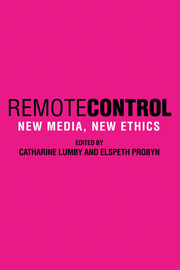Book contents
- Frontmatter
- Contents
- List of Contributors
- Acknowledgements
- 1 Introduction: An Ethics of Engagement
- 2 Real Appeal: The Ethics of Reality TV
- 3 Arguing about Ethics
- 4 ‘Their own media in their own language’
- Beyond the Disconnect: Practical Ethics
- 5 A Viable Ethics: Journalists and the ‘Ethnic Question’
- 6 Ethics, Entertainment and the Tabloid: The Case of Talkback Radio in Australia
- Money versus Ethics
- 7 Eating into Ethics: Passion, Food and Journalism
- Beyond Food Porn
- 8 Ethics impossible? Advertising and the Infomercial
- Pitching to the ‘Tribes’: New Ad Techniques
- 9 Diary of a Webdiarist: Ethics Goes Online
- 10 Control-SHIFT: Censorship and the Internet
- Representing the Asylum Seekers
- 11 The Ethics of Porn on the Net
- Ethics and Sex
- 12 Grassroots Ethics: The Case of Souths versus News Corporation
- 13 Great Pretenders: Ethics and the Rise of Pranksterism
- The Limits of Satire
- Index
Representing the Asylum Seekers
Published online by Cambridge University Press: 18 December 2009
- Frontmatter
- Contents
- List of Contributors
- Acknowledgements
- 1 Introduction: An Ethics of Engagement
- 2 Real Appeal: The Ethics of Reality TV
- 3 Arguing about Ethics
- 4 ‘Their own media in their own language’
- Beyond the Disconnect: Practical Ethics
- 5 A Viable Ethics: Journalists and the ‘Ethnic Question’
- 6 Ethics, Entertainment and the Tabloid: The Case of Talkback Radio in Australia
- Money versus Ethics
- 7 Eating into Ethics: Passion, Food and Journalism
- Beyond Food Porn
- 8 Ethics impossible? Advertising and the Infomercial
- Pitching to the ‘Tribes’: New Ad Techniques
- 9 Diary of a Webdiarist: Ethics Goes Online
- 10 Control-SHIFT: Censorship and the Internet
- Representing the Asylum Seekers
- 11 The Ethics of Porn on the Net
- Ethics and Sex
- 12 Grassroots Ethics: The Case of Souths versus News Corporation
- 13 Great Pretenders: Ethics and the Rise of Pranksterism
- The Limits of Satire
- Index
Summary
How did you initially become interested in the issues surrounding asylum seekers?
After The Monkey and the Dragon came out, I had a couple of ideas for novels in mind;but I was so angry about the whole ‘children overboard’ business, the Tampa, and our treatment of asylum seekers, I wanted to do something which addressed that issue first. I had been interested in writing for theatre for a long time, and it occurred to me that what I wanted to do was to write a comedy with a very punchy message about asylum seekers. I came up with the idea for Seeking Djira, which is about a bunch of self-obsessed Australian writers at a writers' centre who are unexpectedly confronted with an asylum seeker who has escaped from Villawood [a detention centre in Sydney]. Everyone's very confused about who the other people are: he thinks he's stumbled into some weird, dysfunctional family, and they think that he's the famous Middle Eastern poet who they're expecting. So it's a comedy of errors, written in the style of a classic bedroom farce. Anyway, I was starting to write this play when I realised I'd never met an asylum seeker, and had no idea how to do the character. I went to Villawood with the intention of going only a few times, to do some research. But I became very involved with the people I met and so, since November 2001, my whole life has revolved around asylum seekers.
- Type
- Chapter
- Information
- Remote ControlNew Media, New Ethics, pp. 189 - 195Publisher: Cambridge University PressPrint publication year: 2003



